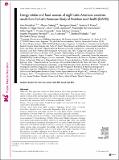Mostrar el registro sencillo del ítem
Energy intake and food sources of eight Latin American countries: results from the Latin American Study on Nutrition and Health (ELANS)
| dc.creator | Kovalskys, Irina | |
| dc.creator | Fisberg, Mauro | |
| dc.creator | Gómez Salas, Georgina | |
| dc.creator | Pareja, Rossina Gabriela | |
| dc.creator | Yépez García, Martha Cecilia | |
| dc.creator | Cortés Sanabria, Lilia Yadira | |
| dc.creator | Herrera Cuenca, Marianella | |
| dc.creator | Rigotti, Attilio | |
| dc.creator | Guajardo, Viviana | |
| dc.creator | Zalcman Zimberg, Ioná | |
| dc.creator | Previdelli, Ágatha Nogueira | |
| dc.creator | Moreno Aznar, Luis Alberto | |
| dc.creator | Koletzko, Berthold V. | |
| dc.date.accessioned | 2021-01-14T16:11:52Z | |
| dc.date.available | 2021-01-14T16:11:52Z | |
| dc.date.issued | 2018-05 | |
| dc.identifier.citation | https://www.cambridge.org/core/journals/public-health-nutrition/article/energy-intake-and-food-sources-of-eight-latin-american-countries-results-from-the-latin-american-study-of-nutrition-and-health-elans/C596537E85BC11F65D077277F3E16F61 | |
| dc.identifier.issn | 1368-9800 | |
| dc.identifier.issn | 1475-2727 | |
| dc.identifier.uri | https://hdl.handle.net/10669/82328 | |
| dc.description.abstract | Objective: Few previous studies in Latin America (LA) have provided data on dietary intake composition with a standardized methodology. The present study aimed to characterize energy intake (EI) and to describe the main food sources of energy in representative samples of the urban population from eight LA countries from the Latin American Study in Nutrition and Health (ELANS). Design: Cross-sectional study. Usual dietary intake was assessed with two non-consecutive 24 h dietary recalls. Setting: Urban areas from eight countries (Argentina, Brazil, Chile, Colombia, Costa Rica, Ecuador, Peru, Venezuela), September 2014 to July 2015. Subjects: Adolescents and adults aged 15–65 years. Final sample comprised 9218 individuals, of whom 6648 (72·1 %) were considered plausible reporters. Results: Overall, mean EI was 8196 kJ/d (1959 kcal/d), with a balanced distribution of macronutrients (54 % carbohydrate, 30 % fat, 16 % protein). Main food sources of energy were grains, pasta and bread (28 %), followed by meat and eggs (19 %), oils and fats (10 %), non-alcoholic homemade beverages (6 %) and ready-to-drink beverages (6 %). More than 25 % of EI was provided from food sources rich in sugar and fat, like sugary drinks, pastries, chips and candies. Meanwhile, only 18 % of EI was from food sources rich in fibre and micronutrients, such as whole grains, roots, fruits, vegetables, beans, fish and nuts. No critical differences were observed by gender or age. Conclusions: Public health efforts oriented to diminish consumption of refined carbohydrates, meats, oils and sugar and to increase nutrient dense-foods are a priority in the region to drive to a healthier diet. | es_ES |
| dc.description.sponsorship | The ELANS is supported by a scientific grant from the Coca-Cola Company (Atlanta, GA, USA) and by grants and/or support from ILSI Argentina, Instituto Pensi/Hospital Infantil Sabara, Universidad de Costa Rica, Pontificia Universidad Católica de Chile, Pontificia Universidad Javeriana, Universidad Central de Venezuela/Fundación Bengoa, Universidad San Francisco de Quito and Instituto de Investigación Nutricional de Perú. The funders had no role in study design, data collection, analysis, the decision to publish or the preparation of this manuscript. | es_ES |
| dc.language.iso | en_US | es_ES |
| dc.source | Public Health Nutrition 21(14) | es_ES |
| dc.subject | Ingesta energética | es_ES |
| dc.subject | Alimentos | es_ES |
| dc.subject | Nutrición | es_ES |
| dc.title | Energy intake and food sources of eight Latin American countries: results from the Latin American Study on Nutrition and Health (ELANS) | es_ES |
| dc.type | artículo original | |
| dc.identifier.doi | https://doi.org/10.1017/S1368980018001222 | |
| dc.description.procedence | UCR::Vicerrectoría de Docencia::Salud::Facultad de Medicina::Escuela de Medicina | es_ES |


